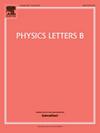Gravitational waves from extreme mass ratio inspirals around rotating black holes surrounded by dark matter halo
IF 4.5
2区 物理与天体物理
Q1 ASTRONOMY & ASTROPHYSICS
引用次数: 0
Abstract
Dark matter (DM) has become one of the biggest mysteries in the universe. The next generation gravitatinal wave (GW) detector is designed to detect low-frequency GWs emanating from extreme-mass-ratio-inspiral systems (EMRIs), this provides possibilities to detect DM with low-frequency GWs. In this paper, we calculate the GWs emanating from EMRIs with central SBH being rotating BH surrounded by DM halo (DMBH) and study the effects of DM on the waveforms of GW. We give the orbit of the secondary body by Hamilton-Jacobi (HJ) method, and calculate GWs with numerical Kludge (NK) method. By comparing the waveforms of GWs of DMBH and that of Kerr BH, we find there exist dephasing between the two waveforms. Through calculating mismatch of the two waveforms it's found mismatch increases with the DM parameter but decreases with the DM parameter . As increases or decreases, the indistinguishable lower bound may be exceeded, then the gravitational waveforms of DMBH and that of Kerr BH are distinguishable. This allows to distinguish the GWs of DMBH from that of Kerr BH and constrain DM parameters with the observation data of the next generation GW detectors. In addition, the dephasing of the two waveforms is found to increase with the eccentricity of orbit, so more eccentric orbits will help to constrain the DM parameters further.
来自极端质量比的引力波在被暗物质晕包围的旋转黑洞周围吸气
暗物质(DM)已经成为宇宙中最大的谜团之一。下一代引力波(GW)探测器被设计用于探测来自极端质量比吸气系统(EMRIs)的低频引力波,这为用低频引力波探测DM提供了可能性。在本文中,我们计算了以DM光晕环绕的旋转BH为中心的EMRIs发射的GW,并研究了DM对GW波形的影响。我们用Hamilton-Jacobi (HJ)方法给出了副天体的轨道,用数值Kludge (NK)方法计算了GWs。通过比较DMBH和Kerr BH的GWs波形,我们发现两种波形之间存在消相现象。通过计算两种波形的失配,发现失配随DM参数cq的增大而增大,随DM参数ωq的减小而减小。当cq增大或ωq减小时,可能会超过不可区分的下界,这时DMBH和Kerr BH的重力波形就可以区分。这使得可以区分DMBH和Kerr BH的GW,并使用下一代GW探测器的观测数据约束DM参数。此外,发现两种波形的消相随轨道偏心度的增加而增加,因此更偏心的轨道将有助于进一步约束DM参数。
本文章由计算机程序翻译,如有差异,请以英文原文为准。
求助全文
约1分钟内获得全文
求助全文
来源期刊

Physics Letters B
物理-物理:综合
CiteScore
9.10
自引率
6.80%
发文量
647
审稿时长
3 months
期刊介绍:
Physics Letters B ensures the rapid publication of important new results in particle physics, nuclear physics and cosmology. Specialized editors are responsible for contributions in experimental nuclear physics, theoretical nuclear physics, experimental high-energy physics, theoretical high-energy physics, and astrophysics.
 求助内容:
求助内容: 应助结果提醒方式:
应助结果提醒方式:


